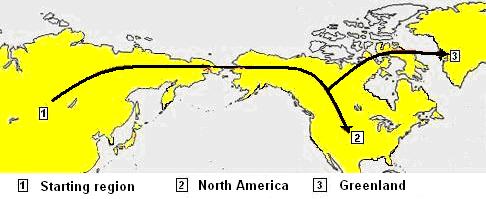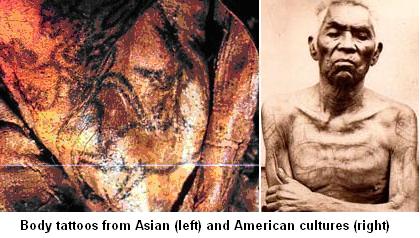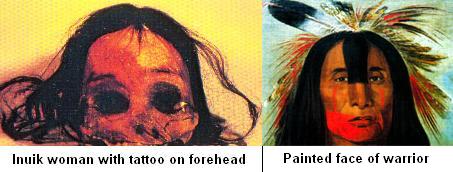|
The
severe climatic changes which transformed Central Asia into an
inhospitable landmass created several waves of migrations in
every conceivable direction. The North-East expansion of these
tribes guided them towards the Bering Straight and from there
into the vast prairies of North America (see Chapter 28,
Maya Cities and Pyramids). Genetic and Linguistic
correlations among Asiatic people and North American so called
“native people” have already been discussed in Chapter 11,
The Eastern Expansion.
The
cultural relationships among these people go far beyond
language similarities, extending to common spiritual beliefs,
burial rites and even body tattoos. On the map below,
indicated as [1], we see the approximate region from where the
North-Eastern expansion started.

Crossing the
Bering straight which was a land-bridge during these early
times they reached the new continent and even crossed over to
the coastal regions of Greenland.
A typical
common cultural trait is the tattooing habits found among
these people. On the picture below-left we see the tattoo
found on the shoulder of the frozen body of a woman buried
deep inside a Pazyryk kurgan (see Chapter 4,
The Asiatic
Scythians). On the right side we see a Haida man with body
tattoos. The Haida is a tribe from the Northwestern coast of
the American continent. Trudy Griffin-Pierce says
(1):
Tattooing was
widely practiced on the Northwest Coast. Men and women had
crest designs tattooed on their chests, arms and legs. The
tattoos on the body of this Haida man represent events and
crest figures from his family history.

The tattoos on the shoulder of the Asiatic woman as well as on
the body the Haida man were not done for decoration purposes
but most probably for connecting these people to the spirits
of their ancestors. We find a similar example in Europe. In
1991 the body of a 5000-year-old mummified man, know as
"Oetzi," was found on the Alp Mountains of the
Italian-Austrian border. This interesting European discovery
puzzled researchers because of the tattoos found on several
parts of his body. Some scientists believe that these tattoos
were done for medical purposes
(2).
Sjövold, professor of Historical Osteology at the University
of Stockholm says that the oldest medical tattoos have been
seen on people from the Scythian culture which lived long ago
on the Altai Mountains in Siberia. Below we see “Oetzi” found
near Oetztal - Austria and the marking on his right ankle.

Several cultural habits, such as body tattooing, connect the
5000-year-old European people to the Asiatic ones and indicate
that common practices existed across continents. Similar body
tattoos could either be shamanic markings for healing purposes
- therefore spiritual - or seals indicating worldly tribal
connections (see Chapter 3, The Hidden Meaning of
Petroglyphs).
Such tattoos
could be done on different parts of the body, including the
face and the forehead. For women they represented marriage
status as still found in the form of a colored mark on the
forehead of most married women of India. For men they
represented spiritual markings connecting them to their
ancestor, from which they could assemble warring power. Below
we see on the left the skull of an Inuik woman found in the
town of Qilakitsoq of Greenland
(3). Eight frozen bodies were
discovered, some of them marked with facial tattoos. In the
article reporting this find it is said:
The tattoos
were made by drawing a needle and stained thread through the
skin. Tattoos also helped to identify the various communities
of Greenland’s early Eskimos – who, though far-flung along a
vast coastline, were one people sharing one language.

These words
support the claim that some tattoos were seals
(tamga)
indicating that the person carrying them pertain to a given
tribe and some other ones were spiritual power symbols. Above
left we see the 500 year old skull of an Inuik woman found in
a grave of Greenlad. The marking on her forehead could only be
identified with the help of infrared light. On the right side
we see a painting of a North American warrior who has partly
colored his face in red (4). Painting the face before going to
war was a common cultural practice among North American
chieftains. They colored their face temporarily for gathering
power and scaring their enemies. Tattoos, on the other hand,
were permanent symbols that remained during their entire life.
|